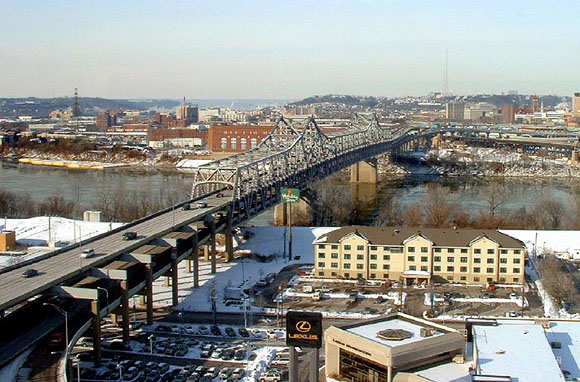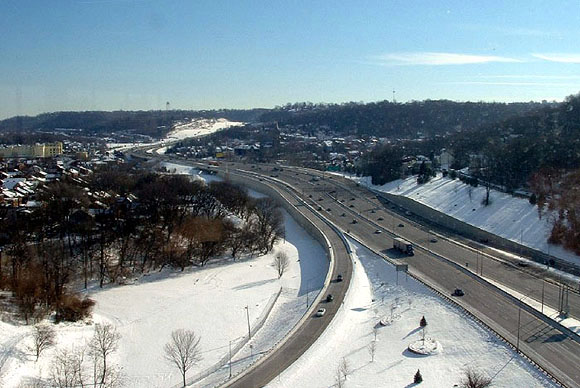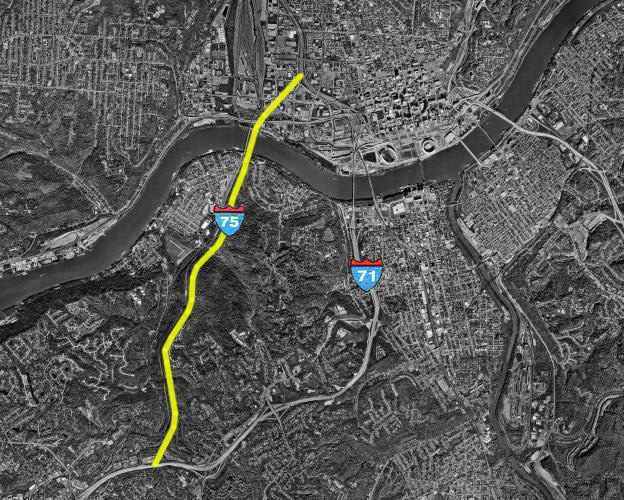[Photo courtesy www.cincyimages.com]

I-71/75 BRENT SPENCE BRIDGE
The Brent Spence Bridge is typical of the cantilever truss design, with a main span of 830.5ft. and approach spans each measuring 453ft. It opened in November of 1963 with its two decks striped for three lanes each, however their emergency shoulders were eliminated in 1986 and the decks restriped for four lanes. Traffic has overwhelmed the bridge for decades, and its future is uncertain. The prospect of its replacement is currently under study, and including associated approaches and interchanges is currently estimated to cost $750 million. It is unlikely that new construction will begin before 2010. The upcoming project is discussed in the Brent Spence Replacement article.

This postcard from around 1984 shows the bridge's original Covington approach, sporting just two
through lanes in each direction. Piers appear to have been built at the time of the bridge's construction
anticipating restriping of the bridge decks and reconfiguration of the approaches.
I-75 is among the world's most important roadways and the second busiest Interstate Highway. Since 1970 I-71 has been routed over the bridge as well. But the bulk of traffic seen daily on the bridge is a result of the tremendous suburban growth that the bridge and I-71/75 enabled in Northern Kentucky. After the expressway opened, access to the hilly countryside just south of downtown Cincinnati was greatly improved, and the area was soon overrun by the predictable mix of subdivisions, shopping centers, apartment complexes, office parks, and light industry. Aside from the expressway, much of the area's growth was spurred by the Cincinnati/Northern Kentucky International Airport, located about six miles from the bridge, and it is reasonable to assume that had the region's airport been built north of the river, the bridge wouldnot have become the bottleneck it is today.

A nearby electric substation complicates new bridge plans.
[August 1, 2005 Jake Mecklenborg]
Despite its bad reputation, northbound I-71/75and the Brent Spence Bridge form one of the most dramatic approaches toany city in the United States. The panoramic hillside approach anddescentto the bridge show off the downtown Cincinnati skyline and itssurroundinghills at their most impressive angle. And after fifteen miles ofmonotonous suburbs, drivers are suddenly surrounded by the 19th centuryscale of Covington, with brick row buildings and traditional cityblocks lining either side of the expressway.

2004 view of I-71/75 through Covington.
[www.cincyimages.com]
I-75's Ohio River crossing was originally planned tobebuilt about a mile west, parallel to the CincinnatiSouthern Railroad Bridge inLudlow. For those familiar with local topography, the advantages of this routeparalleling the railroad are obvious, as it descends a much morerelaxedgrade to the river and the Kentucky side bridge approach would havemoweddown far fewer buildings. About four total miles would havebeen built differently to accommodate the different bridgelocation. North of the river, the I-71 split could have been much betterengineered,with the functional equivalent of Ft. Washington Way built at LibertySt.or more likely Central Parkway. Covington boosters foughtforthe expressway even though it required demolition of hundreds of thecity'sbuildings, the treacherous Covington "Death Hill" and its subsequentreconstruction in the early 1990's, and caused a cramping of the I-71splitnorth of the bridge in Cincinnati.

Yellow shows originally planned 1950's "Ludlow" routing of I-75. This graphic shows how the
Ludlow Routing,if built today, could function in tandem with the existing expressway.
Brent Spence Tunnel?
Originally a tunnel was proposed for the river crossingin this location, as part of the expressway network Cincinnati designedin 1947 and planned to build with state and local funds before theFederalInterstate Highway Act passed in 1956. Had the tunnel been built itwouldlikely have been no more than four total lanes divided between twotubesand the expressway itself would have been built to crude pre-interstatestandards. Had it later been designated as interstate 71/75 it wouldhavebecome quickly overloaded in a fashion similar to Boston's recentlydemolished I-93. Had itnot been designated an interstate, the tunnel and its primitiveexpresswaywould have become a pre-interstate relic in the Cincinnati road networkakin to the WesternHills Viaduct or Columbia Parkway.
Tunnel under the Ohio? Idea considered in 1955
The Kentucky Post 2-15-97
[no author listed]
Today most people take the Ohio River bridges for
granted. The only time one thinks much about them is
when an accident happens or repairs delay traffic.
But in 1955 bridges were front-page news. Five bridges
spanned the Ohio River between Northern Kentucky and
Cincinnati in 1955. In Covington there were the
Suspension and C&O bridges. In Newport there were the
Central and L&N bridges. And in Ludlow there was the
Southern Bridge, which was limited to railroad
traffic.
All five bridges were built in the 1800s with the
first, the Suspension Bridge, opening to pedestrians
in 1866.
By 1955 decision-makers were asking whether Northern
Kentucky needed another bridge, and if so, where it
should be located.
In Northern Kentucky, many felt construction of
another bridge was long overdue. A lobbying effort was
started to persuade state officials to finance a
bridge. The existing five bridges had all been built
by private companies.
The proposed bridge was to cross the Ohio River
somewhere near where Willow Run Creek empties into the
Ohio River. Proponents saw such a bridge as part of a
larger scheme to develop a super highway, possibly
with limited access, that would connect the new
airport in Boone County more directly to Cincinnati.
By 1955, routes for a road were studied. One would
have followed the old street car route up through Park
Hills and Ft. Mitchell.
In June 1955, state Rep. Thomas P. Fitzpatrick tossed
a curve ball into the debate. The representative from
Kenton County proposed that instead of a bridge, the
state should consider tunneling under the Ohio River
just east of where the C&0 Bridge crossed the Ohio
River.
Fitzpatrick said the tunnel could go under Third
Street or even Fifth Street in Covington and come out
in Cincinnati wherever Ohio officials felt was most
appropriate. He said a tunnel might address Cincinnati
concerns about another bridge dumping traffic onto its
riverfront area.
Fitzpatrick added, ''Kentucky should keep its sights
focused on progress at all times and this, in my
opinion, is certainly a progressive move for obvious
reasons.''
The Kentucky Post called for a conference between
Kentucky and Ohio officials to discuss the best way to
span the Ohio River and to promote quicker access from
Cincinnati to Boone County. A conference was held on
July 20 and included state and local officials from
both Kentucky and Ohio. Covington Mayor John Moloney
hosted the meeting.
The tunnel proposal received mixed reactions, but Ohio
Gov. Frank Lausche thought enough of the concept to
order his state's highway department to study the
feasibility of a tunnel.
Fitzpatrick, meanwhile, started a letter-writing
campaign to keep the tunnel idea alive. He said
engineers indicated a tunnel was feasible and
practical. As to cost, Fitzpatrick admitted he had no
estimate of what it would take to build a tunnel, but
he speculated it would be ''a lot of millions.''
Fitzpatrick said the higher construction costs of a
tunnel would be offset by fewer maintenance expenses
from wind, rain and storm damage.
Former Gov. A. B. ''Happy'' Chandler, a candidate
again for governor in 1955, lent his support to some
type of new ''structure'' across the Ohio River at
Covington. A spokesman said the word ''structure'' was
used because Chandler wasn't sure whether a bridge or
tunnel would be better.
Among the biggest critics of the tunnel proposal was
Cincinnati City Engineer T. J. Montgomery. He said the
1937 flood had demonstrated the Ohio River could
expand much further than previously predicted and
entrances for a tunnel would have to be built far
enough away from the river to stay dry at flood levels
of up to 84 feet.
Montgomery said the flooding problem was especially a
Northern Kentucky concern as the ground in Covington
remained relatively level for a great distance from
the river.
The Kentucky Post came out against the tunnel concept,
saying a tunnel study would only delay construction
and confuse Kenton County voters. At the time Kenton
voters were being asked to approve a bond issue for
the proposed new airport highway.
In July 1955 Gov. Lawrence Wetherby announced his
support for a bridge, rather than a tunnel. Ohio
officials latered also endorsed the bridge concept.
Fitzpatrick said the tunnel critics were rejecting the
concept for political reasons. Fitzpatrick said
Wetherby was supporting Bert Combs for governor and
Combs backed a new bridge. Chandler and Combs were
squaring off that year in the Democratic primary for
governor, which Chandler won.
While the project to build either a bridge or tunnel
languished, Kenton County voters approved a $1 million
bond issue in 1955 to buy land for the limited access
road through the county for the proposed
airport-to-Cincinnati road.
Then both the bridge-tunnel talk and the new highway
were put on hold. The reason was plans by federal
officials for a nationwide expressway system that were
to include the proposed access road from Cincinnati to
the airport in the expressway route.
The expressway plans delayed work for a couple more
years. It was not until 1957 that the purchase of
expressway right-of-way between Covington and
Lexington was authorized.
Interstate 75 in Covington was built over Willow Run
Creek as originally proposed in the access road plan.
And on the site of the proposed 1955 bridge-tunnel the
Brent Spence Bridge was built. Named after the 16-term
Democratic congressman, it opened Nov. 25, 1963.
Bert Combs, meanwhile, defeated by Chandler in 1955,
won the election for governor in 1959. The Interstate
275 bridge over the Ohio River at Coney Island was
named for him and Campbell County Judge Lambert Hehl.
TUNNEL PROPOSAL DIDN'T HURT FITZPATRICK IN POLITICAL
ARENA
While some politicians might have suffered politically
for proposing a river tunnel, Thomas P. Fitzpatrick's
political star wasn't tarnished.
Fitzpatrick, best known as ''Timmy,'' continued to be
a colorful and respected Democratic politician in
Northern Kentucky.
In his younger days Fitzpatrick was a highly regarded
lightweight boxer. He later became a boxing referee
and promoter.
During World War I, he served in the Navy. He entered
politics in 1933, when he ran and was elected state
representative from Kenton County. Fitzpatrick was
subsequently re-elected to four consecutive terms.
In 1943, Fitzpatrick ran for Covington mayor on an
anti-administration ticket and defeated R. E.
Culbertson, 7,115 to 4,459. Fitzpatrick followed that
up in 1947 by being
elected Kenton County sheriff. When his term as
sheriff was completed, Fitzpatrick retired from
politics, but only for a couple of years. He returned
to the state legislature in 1954.
Upon his return, Fitzpatrick was elected to three more
terms in the Kentucky House. He was chosen House
speaker in 1956 and in 1959 returned as House speaker
after Morris Weintraub of Newport stepped down.
Fitzpatrick was at a legislative session in 1962 when
he became ill with asthma and was admitted to King's
Daughters Hospital in Frankfort. He died at St.
Elizabeth Hospital in Covington on June 22, 1962.
An editorial in The Kentucky Post on June 25, 1962,
said Fitzpatrick was a good political organizer and
astute in keeping up with the interests of his
constituents. As a legislator, The Kentucky Post said
Fitzpatrick had a statewide reputation as a champion
of home rule, who spoke his mind and always let people
know where he stood on issues.
The study of Northern Kentucky history is an avocation
of staff writer Jim Reis, who covers suburban Kenton
County for The Kentucky Post.
Publication date: 12-15-97
1. RecentBrent Spence Bridge Photos2. BrentSpence Replacement Page
3. BacktoMain




